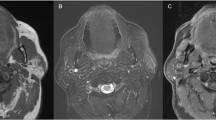Abstract
Intraductal carcinoma of the salivary gland is a rare, indolent neoplasm characterized by intraductal malignant cell proliferation but lacking invasiveness, in contrast to conventional salivary duct carcinoma, a clinically aggressive neoplasm with invasive characteristics. The tumor affects the major salivary glands much more frequently than the minor salivary glands. This report describes an extremely rare intraductal carcinoma arising from the buccal mucosa in a 61-year-old man who presented with a painless mass in the left buccal mucosa, which he had had for 1 month. A biopsy of the tumor indicated it was most likely an adenocarcinoma, but accurate preoperative diagnosis was difficult. The tumor was completely removed, along with sufficient margins. Histological examination revealed that the lesion was composed of proliferating epithelial cells surrounded by an intact myoepithelial layer, with no evidence of invasion. The final diagnosis was intraductal carcinoma of the salivary gland. No recurrence has been observed for over 3 years. In conclusion, the difficulty in preoperatively diagnosing this rare entity suggests that complete surgical excision with sufficient margins remains the best treatment option.



Similar content being viewed by others
References
Kuo YJ, Weinreb I, Perez-Ordonez B (2013) Low-Grade salivary duct carcinoma or low-grade intraductal carcinoma? Head Neck Pathol 7:59–67
Chen KT (1983) Intraductal carcinoma of the minor salivary gland. J Laryngol Otol 97:189–191
Cheuk W, Chan JK (2007) Advances in salivary gland pathology. Histopathology 51(1):1–20
Delgado R, Klimstra D, Albores-Saavedra J (1996) Low grade salivary duct carcinoma: a distinctive variant with a low grade histology and a predominant intraductal growth pattern. Cancer 78:958–967
Cheuk W, Miliauskas JR, Chan JK (2004) Intraductal carcinoma of the oral cavity: a case report and a reappraisal of the concept of pure ductal carcinoma in situ in salivary duct carcinoma. Am J Surg Pathol 28:266–270
Chen KT (2000) Cytology of salivary duct carcinoma. Diagn Cytopathol 22:132–134
Khurana KK, Pitman MB, Powers CN et al (1997) Diagnostic pitfalls of aspiration cytology of salivary duct carcinoma. Cancer 81:373–378
Tatemoto Y, Ohno A, Osaki T (1996) Low malignant intraductal carcinoma on the hard palate: a variant of salivary duct carcinoma? Eur J Cancer B Oral Oncol 32:275–277
Watatani K, Shirasuna K, Aikawa T et al (1991) Intraductal carcinoma of the tongue: report of a case. Int J Oral Maxillofac Surg 20:175–176
Anderson C, Muller R, Piorkowski R et al (1992) Intraductal carcinoma of major salivary gland. Cancer 69:609–614
Delgado R, Klimstra D, Albores-Saavedra J (1996) Low grade salivary duct carcinoma: a distinctive variant with a low grade histology and a predominant intraductal growth pattern. Cancer 78:958–967
Brandwein-Gensler M, Hille J, Wang BY et al (2004) Low-grade salivary duct carcinoma: description of 16 cases. Am J Surg Pathol 28(8):1040–1044
Simpson RH (2013) Salivary duct carcinoma: new developments—morphological variants including pure in situ high grade lesions; proposed molecular classification. Head Neck Pathol 7:48–58
Michal M, Skalova A, Simpson RH et al (1999) Cribriform adenocarcinoma of the tongue: a hitherto unrecognized type of adenocarcinoma characteristically occurring in the tongue. Histopathology 35:495–501
Wenig BM (2008) Atlas of head and neck pathology. In: Major and minor salivary glands, 2nd edn. Elsevier Health Sciences, pp 664–665
Hellquist H, Skalova A (2014) Other Carcinomas. Springer-Verlag, Berlin Heidelberg, Heidelberg, Histopathology of the salivary gland, pp 392–422
Silverstein MJ, Rosser RJ, Gierson ED et al (1987) Axillary lymph node dissection for intraductal carcinoma: Is it indicated? Cancer 59:1819–1824
Simpson RH, Desai S, Di Palma S (2008) Salivary duct carcinoma in situ of the parotid gland. Histopathology 53(4):416–425
Acknowledgments
We are very grateful to Dr. JKC Chan, Department of Pathology, Queen Elizabeth Hospital for providing valuable suggestions.
Conflict of interest
All authors declare that they have no conflict of interest.
Author information
Authors and Affiliations
Corresponding author
About this article
Cite this article
Nojima, J., Nakahira, M., Yamaguchi, H. et al. An extremely rare salivary gland tumor: intraductal carcinoma of the buccal mucosa. Int Canc Conf J 5, 53–56 (2016). https://doi.org/10.1007/s13691-015-0225-7
Received:
Accepted:
Published:
Issue Date:
DOI: https://doi.org/10.1007/s13691-015-0225-7




